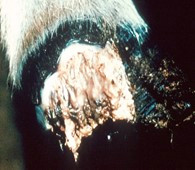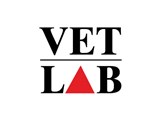CASE STUDY
The following study is based on submissions to our laboratory and is for educational purposes only. Readers may not reproduce or copy this content on this website, including files downloadable from this website, without the permission of the copyright owner.
History
A sheep is observed to be lame and its wool not as thick as the rest of the flock that is being sold at the auction yard. The hooves are examined and there appear to be lesion on the hooves.

A scraping using a dry clean swab is taken from the hoof of a sheep with a lesion score of 3 is placed into a Modified STM (Stuarts Transport Media-available from the laboratory) and sent to the laboratory for examination by microscopy and culture on specialised culture media.
Laboratory Findings
The gram stained smear made from the swab is examined and large gram negative rods with rounded ends (dumb-bell appearance) are detected.

The hoof scraping is plated onto specialised hoof agar culture media plates and incubated anaerobically for 72hrs. Plates are examined every 2-3 days to look for the presence of footrot. The plates are examined to look for colonies of Dichelobacter nodosus (footrot). Sub-culture plates are made to get pure colonies of the bacterium so that further testing can be carried out.
Once the footrot bacterium is detected and purified, it needs to be tested further to determine the virulence of the bacteria. Elastase testing is performed to determine virulence of the Dichelobacter nodosus. Virulent footrot will have a positive elastase result up to and including 12 days. Intermediate footrot will have positive elastase result between 13 and up to and including 16 days. After 16 days the footrot is considered benign.
References
Australian and New Zealand Standard Diagnostic Procedure (ANZSDP) Ovine Footrot, May 2014 (agriculture.gov.au)
Stewart, D.J., Peterson, J.E., Vaughan, J.A., Clark, B.L., Emery, D.J., Caldwell, J.B. and Kortt, A.A., 1986. The pathogenicity and cultural characteristics of virulent, intermediate, and benign strains of Bacteroides nodosus causing ovine footrot. Aust. Vet. J., 63.
Beveridge W.I.B. (1941) Bull Coun Sci Indust Res Aust, No 140.
Depiazzi L.J., Richards, R.B., Henderson, J., Rood J.I., Palmer, M.A and Penhale W.J. (1991) Vet. Microbiol 26: 151.
Pitman D.R., Palmer, M.A., and Depiazzi L.J (1994) Aust Vet J. 71: 109
Further information
CLICK HERE for detailed information from PIRSA about Footrot, including a new video 'Managing Footrot in SA'.



